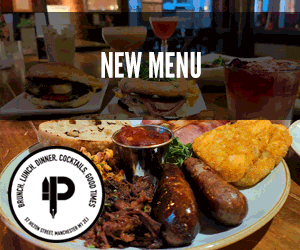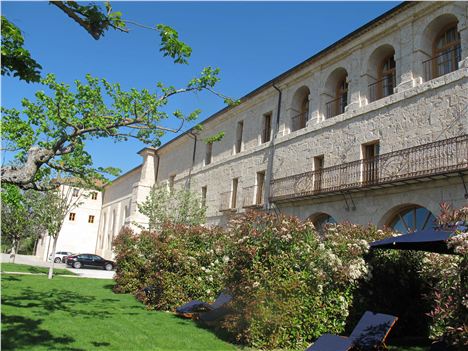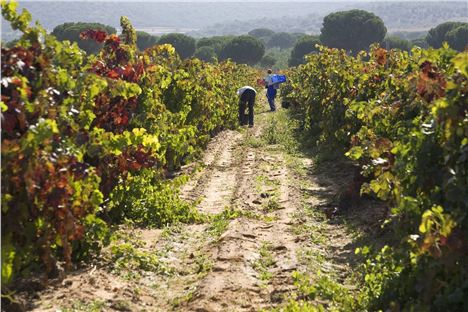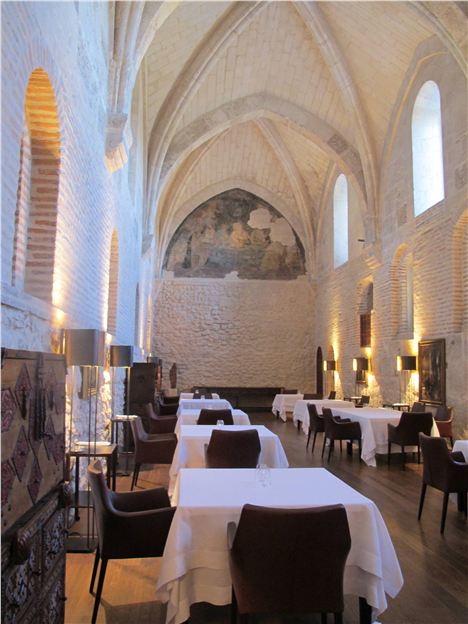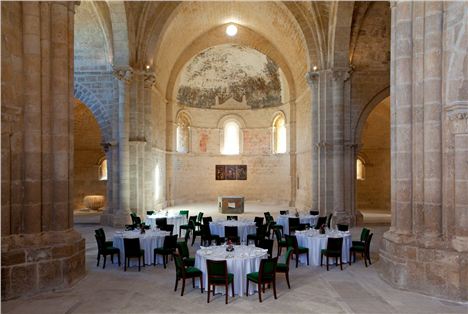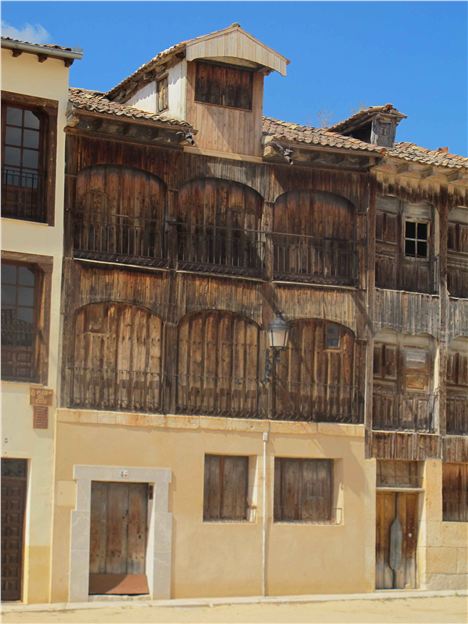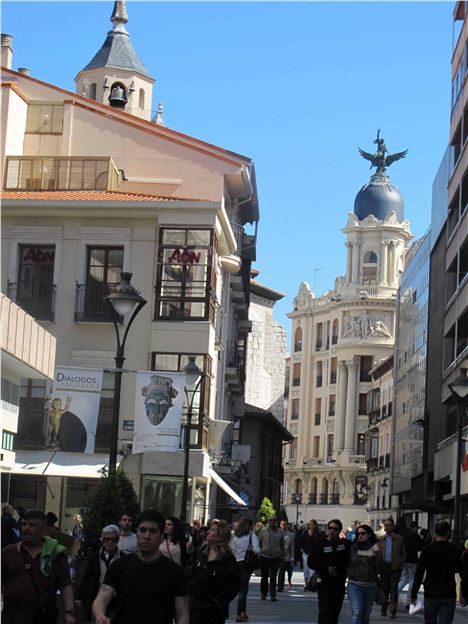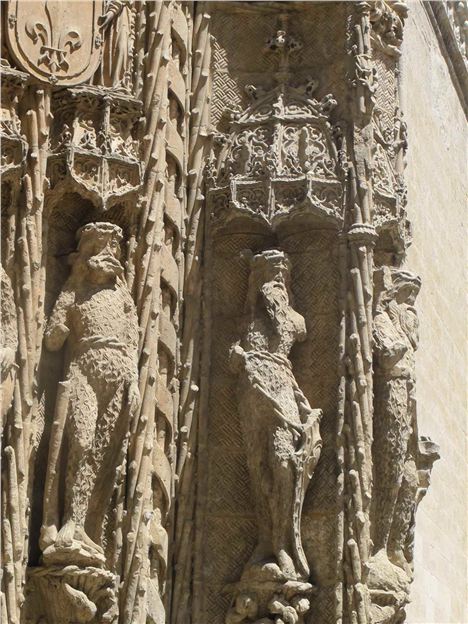STORKS and cranes, the skyline of an abbey fortress surrounded by vineyards. The storks are nesting busily in the 12th century belltower; the cranes, the giant mechanical sort, are at rest. This is a Spanish bank holiday and work will resume tomorrow on turning former monks’ dwellings and stables into eight new guest rooms and a spa/pool complex. To complete the transformation into one of Spain’s finest luxury hotels.
"My Sacristy Menu featured sauteed cuttlefish with a reduction of its own juice, cod cheeks whitened with gelatine with a honey emulsion, market fish with seasonal ragout and its toasted bone juice, then crispy baby lamb with quinoa"
Welcome to Abadia Retuerta, westernmost of the wineries producing some of Spain’s greatest reds along the River Duero’s Golden Mile two hours north of Madrid. Its Relais & Chateau approved lodging, Le Domaine, is the place to stay around here with just 22 rooms and a cuisine curated by one of the country’s Michelin-starred greats.
 Stork atop Le Domaine; below, honeyed stone and flowers
Stork atop Le Domaine; below, honeyed stone and flowers
I’ve only just arrived and barely settled in my room, pausing open to fling open the shuttered windows for an eyeful of vines before I am out among them for a pre-prandial stroll. The view back is equally enchanting – pale, honeyed stone cunningly renovated, harmonising Romanesque and Baroque.
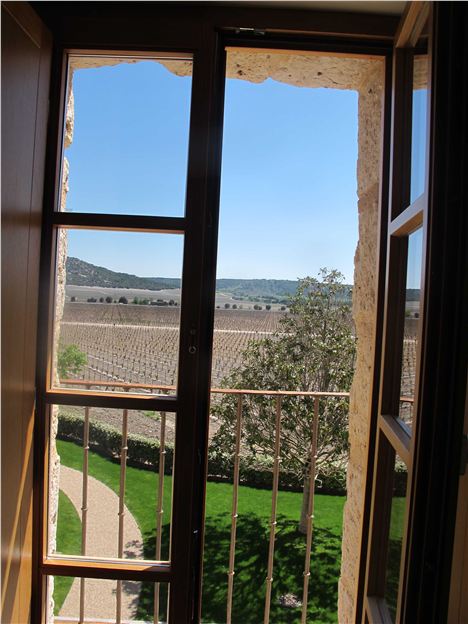 View from my Domaine bedroom; below, harvest time
View from my Domaine bedroom; below, harvest time
Such evenings of mellow sun and blue skies have been rare this spring. At 800m above sea-level here they expect nights to be cold, but it has been uncommonly wet, too, bad for the grapes planted across 700 hectares upon which Abadia’s fortunes are built.
In 2005 their flagship wine, the Seleccion Especial conquered all at the International Wine Challenge, capping a remarkable fast track rise for an operation only begun in 1995. The winning wine was from the 2001 vintage. I never expected to be served a bottle from that year with my dinner in the Refectorio, but there it was, still vigorous yet elegant, the quintessence of tempranillo (with the support of some cabernet sauvignon).
The Refectorio was where the monks ate (and occasionally kept their livestock). Now these soaring white stone vaults are home to Le Domaine’s fine dining restaurant. For the holy men’s simple gruel, root veg and pond fish substitute, in my “Sacristy Menu”, sauteed cuttlefish with a reduction of its own juice, cod cheeks whitened with gelatine with a honey emulsion, market fish with seasonal ragout and its toasted bone juice, then crispy baby lamb with quinoa.
Novaris, the Swiss firm that owns the Abadia Retuerta enlisted Andoni Luis Aduriz of Michelin-starred Mugaritz in the Basque Country to oversee the kitchen operation. He has installed one of his lieutenants but this is less molecular nova cucina, more a modern interpretation of the Ribera del Duero’s culinary traditions.
Similarly in the winery, the owners have gone for internationally recognised expertise. It was designed by legendary Bordeaux oenologist Pascal Delbeck, the man who revived Chateau Ausone. The hand-crafted wines from a range of terroirs and, mainly red, grapes stay true to his philosophy of minimal intervention. I was lucky enough to taste from cask the new vintage of the (primarily sauvignon blanc) Abadia white – one of several experimental wines from “found vines” but equally serious in its quality.
The estate is actually just outside the borders of the official Ribera del Duero wine denominacion, meaning the wines bear the name of the nearest town, Sardon del Duero.
Yet Abadia Retuerta really feels like the cradle of winemaking in the region.
The Santa Maria de Retuerta abbey was originally founded in 1145, by Doña Mayor, wealthy daughter of Count Ansúrez, Lord of Valladolid – one of many fortified religious houses built during the Christian “Re- conquest” of Castile from the Moors. The Ansurez family left “terras et vineas” (land and vines) to the French-based order of St Norbert, which was the beginning of the estate’s long history of producing wine.
 Cloisters at Le Domaine – the garden pavement is modern
Cloisters at Le Domaine – the garden pavement is modern
The abbey, though, after splendid additional building work during the Baroque era, fell into a steep decline until the current sensitive renovation that marries light-filled chic interiors (lots of marble, linen and luxury fittings) in the bedrooms in the Baroque half with the miraculously preserved original church and sacristy. Off the utterly calm cloisters you’ll find an even calmer yoga room, hi-tech meeting rooms and the Vinoteca casual dining space new and old stone all seamlessly joined... while high above the resident stork family keep a beady eye on guests.
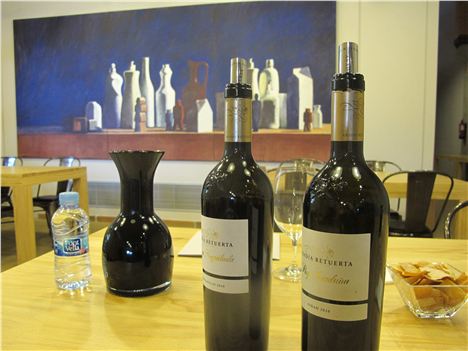 Wine sampling time at Abadia Retuerta; below, the impressive barrel store
Wine sampling time at Abadia Retuerta; below, the impressive barrel store
Most of these come with wine in mind, sampling first at the Abadia Retuerta’s own tasting room in the winery and then visiting rival establishments along the route to “wine capital” Penafiel. Le Domaine offers a unique personal butler service that can sort out all arrangements for you. Hot air balloon trip, helicopter tour or, closer to the soil a horsebak ride? Just ask
 Penafiel Castle rears above the Plaza del Coso – a medieval survivor
Penafiel Castle rears above the Plaza del Coso – a medieval survivor
My butler Juan Pablo ferried me east to Penafiel to see the remarkable, elongated white castle on the hill and the Richard Rogers-designed Protos winery. It’s a workaday place, as wine towns often are, but with lots of attractive tapas haunts and an astonishing enclosed medieval square called the Plaza del Coso. Folk hire the balconies of its private houses when bullfights are held there. On our visit the shutters were closed, a couple of cats snoozed and it shimmered in the sun like the epitome of Old Castile.
 Valladolid is an attractive place to wander under blue skies
Valladolid is an attractive place to wander under blue skies
Our other destination, some 20 minutes west of Abadia Retuerta, was Valladolid, now the regional capital, but once capital of all Spain and all its worldwide empire. The Philippines were named after King Philip II, who was born in Valladolid in 1527 – the house with its distinctive corner window is still there on the corner of the Plaza Mayor, among Spain’s most beautiful main squares.
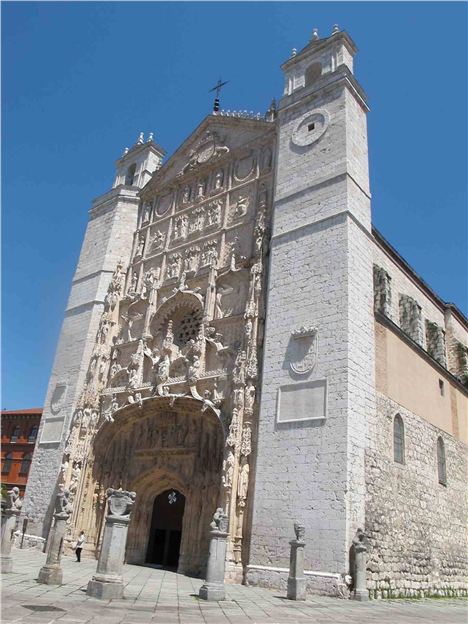 San Gregorio's elaborate facade; close-up below
San Gregorio's elaborate facade; close-up below
The bustling, industrial city Valladolid has become is still full of terrific old buildings, monuments and museums, the pick of which is undoubtedly the National Museum of Sculpture. Devoted to the devotional art of the 15th-18th centuries where the techniques of Renaissance Italy fused with Spain’s religious fervour, it’s housed in three buildings, notably the Colegio de San Gregorio, built in 1487.
The representational skills and emotional intensity of the collection – particularly in the works of Alonso Berruguete and Juan de Juni – are breathtaking. Much of it is gilded polychrome sculpture, which reached its peak in Valladolid. The highlight? Probably Berruguete’s massive dismantled altarpiece, which occupies three whole rooms, but even teh simpler pietas and martyrdoms enthralled me throughout.
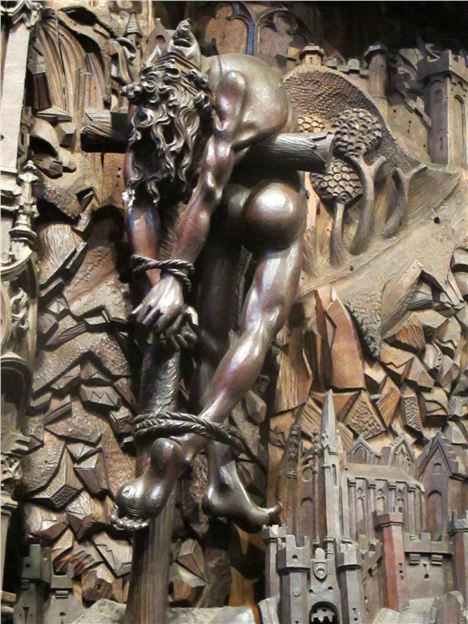 Almost modern in its tortured sensibility this altarpiece detail
Almost modern in its tortured sensibility this altarpiece detail
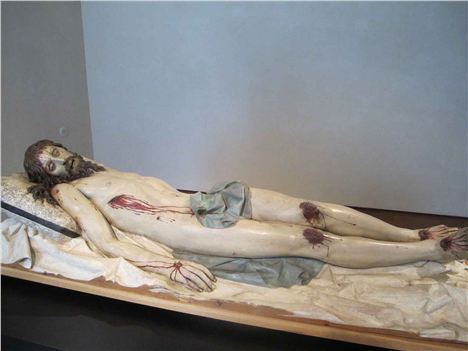 Agony of Christ, Baroque style; below, a pieta simple but profound
Agony of Christ, Baroque style; below, a pieta simple but profound
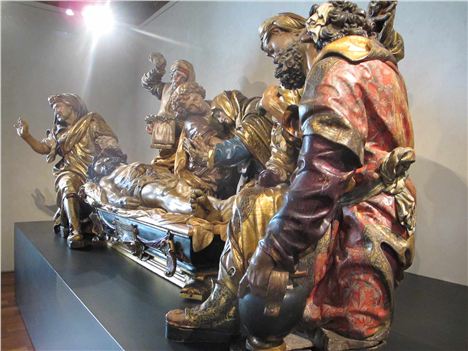 Mannerist masterpiece in the Scupture Museum
Mannerist masterpiece in the Scupture Museum
Eventually the pleasures of the flesh called and a chance to sample the city’s vibrant tapas scene. They call them pinchos here – you forget how far north in Spain we are. The best tapas places cluster around the Calle Correos. La Mina, with its intense proprietor, is an old-fashioned stand-up kind of joint, Vinotinto round the corner more laid-back, but my favourite has to be the atmospheric Las Zagales in the Calle de la Pasion (www.loszagales.com), which has a fine regional wine offering and has won awards in contemporary tapas competitions.
 Awards and specials at Los Zagales; below the Obama tapa
Awards and specials at Los Zagales; below the Obama tapa
Stand-outs, at 2.75 euros each, were Tigretoston, black bread and black pudding and cream cheese turned into a roll resembling a child’s sweet treat with appropriate packaging and, the equally playful (but I’m not sure if entirely politically correct) Obama En La Casa Blanca (Obama in the White House). Maybe the dish loses in the official translation, “pastry base with mushroom sauce, Castilian low temperature egg and potato scorched”, but believe me it was delightful.
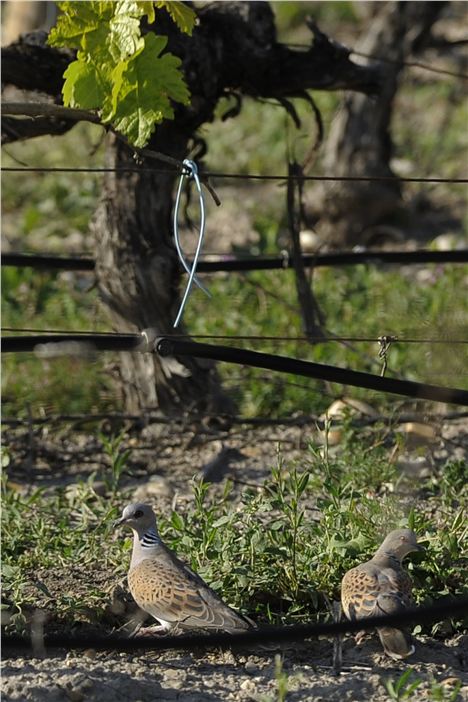 Tórtolas (turtle doves) pecking among the vines
Tórtolas (turtle doves) pecking among the vines
Delightful, too, my last walk before departure at Le Domaine – along a raised path between the Duero Canal and the river proper. The birdlife is abundant and the spring flowers are glorious. The estate pays the same meticulous attention to stewarding the environment as it does to producing proper wine and pampering luxury guests.
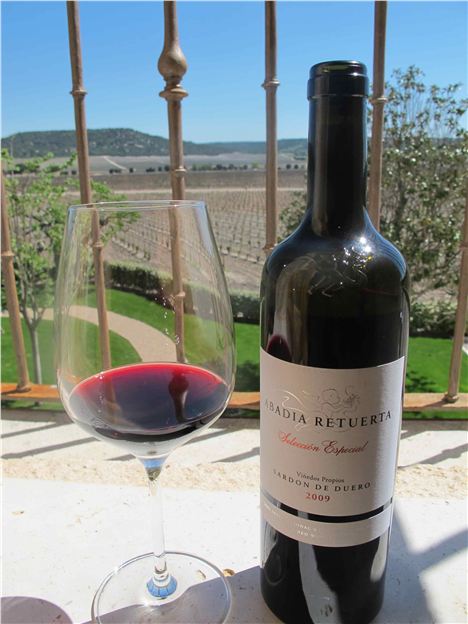 Seleccion Especial, the flagship red at the Abadia Retuerta
Seleccion Especial, the flagship red at the Abadia Retuerta
Mummy stork suddenly takes wing and flaps across the vineyards under a cloudless sky. A final glass of Seleccion Especial awaits me in my cool room. I think I’ve gone to heaven.
Fact file
Getting there:
Neil Sowerby flew to Madrid with British Airways from London Heathrow. www.britishairways.com. A budget alternative is to fly from Liverpool easyJet www.easyjet.com. There is a fast train connection (under an hour) from Madrid Chamartin station.
Staying there:
Abadia Retuerta LeDomaine is an historic medieval Abbey estate of some 700 hectares, located on the banks of the Duero River. With 22 rooms and suites serviced by a team of butlers, the Refectorio Restaurant serving locally-sourced, gastronomic fare, award winning wines from the renowned Abadia Retuerta winery and meeting rooms accommodating 18–200 people, LeDomaine even offers its own outdoor sculpture gallery, The Hedge Museum showcasing works by noted German artist, Ulrich Rückreim.
Rooms starting at just 217 euros per night, inclusive of tax and breakfast. For further information and reservations please visit www.ledomaine.es, email reservations@ledomaine.es or call +34 98 368 0368.
Dishes I ate in the Refectorio at Le Domaine (and some sweetbreads from Los Zagales:
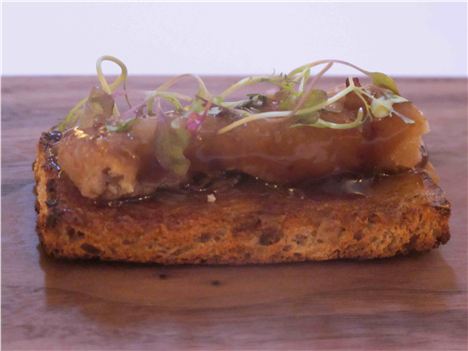 Bone marrow rye toast with onion
Bone marrow rye toast with onion
 Sauteed cuttlefish with a reduction of its own juice and carrots
Sauteed cuttlefish with a reduction of its own juice and carrots
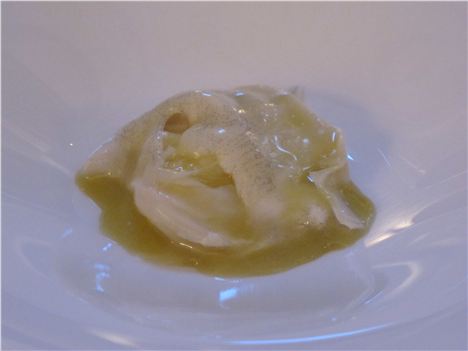 Cod cheeks whitened with gelatine with a honey emulsion
Cod cheeks whitened with gelatine with a honey emulsion
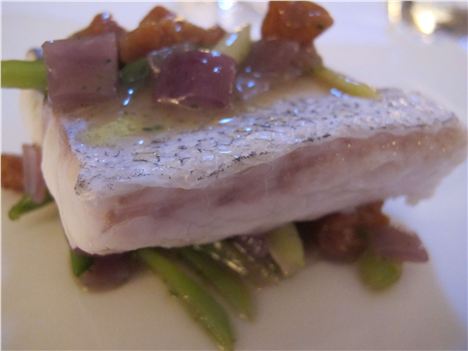 Market fish with seasonal ragout and its toasted bone juice
Market fish with seasonal ragout and its toasted bone juice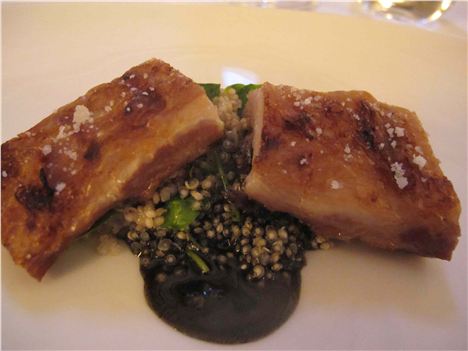 Crispy Baby Lamb With Quinoa In Its Own Juice
Crispy Baby Lamb With Quinoa In Its Own Juice
 Regional cheeses are exquisite
Regional cheeses are exquisite
 Caramelised torrija with mascarpone ice cream
Caramelised torrija with mascarpone ice cream
 Lamb's sweetbreads make a delectable main at Los Zagales
Lamb's sweetbreads make a delectable main at Los Zagales





